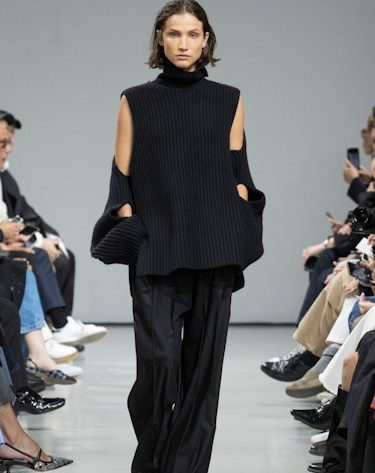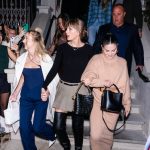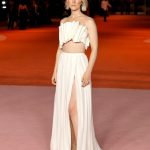Last fall, I found myself trolling the Banana Republic website at 2 a.m., trying to figure out how to get a discount on one of its red Fair Isle sweaters that looked a lot like a designer one I’d been coveting. At the time, I had not visited its website in years, or maybe ever. I also hadn’t been inside one of its stores since high school. But there I was, stumbling for my credit card in the dark because some stylish person I follow, or some publication I trust, maybe both — I don’t remember — told me to do so.
If you, too, have found yourself suddenly interested in the American mall brand for the first time in a long time, welcome to the Bananaissance. After a pandemic slump — due, in part, to the fact that millions of Americans no longer needed the brand’s traditional office clothes — Banana Republic is in the midst of a comeback. Last fall, TikTokers became obsessed with its Vida tote bag, which amassed some 26 million views on the platform at the time. “Banana Republic has had a glow-up, and we need to stop sleeping on it,” declared one fan in a video.
And it’s still glowing. Just one week after the brand launched a new home goods line called BR Home this fall, Meghan Markle was photographed wearing a black Banana Republic shirtdress, instantly selling out the style in most sizes. This month, the brand is also set to release its first collaboration with one of the most promising young designers working in New York, and therefore the entire United States: Peter Do, who teased a few of the looks on his Paris runway.
Peter Do shows several looks from his Banana Republic collection in his Spring/Summer 2024 show.
Of course, this isn’t all just one big coincidence. Banana Republic’s parent company is Gap Inc., which also owns Gap, Old Navy, and Athleta, is perhaps counting on the brand’s renewed success. After a rough go with Kanye West last fall, Gap seems to be struggling to find its footing again, and Old Navy and Athleta remain stagnant from a storytelling perspective. Banana Republic, meanwhile, has a heritage ripe for repurposing, as well as a “quietly luxurious” aesthetic that’s attuned to the current trend wave.
The Vida tote bag, for example, looks a lot like one by the Row, and the sweater I stumbled out of bed for had a close relative in a Fair Isle knit by Khaite. Both of these items are more expensive, and presumably higher quality, than what you might find at other mall brands like J.Crew and Abercrombie & Fitch, or at High Street stores like Zara. But they’re still significantly less pricey than their designer counterparts. The same goes for BR Home — the furniture looks like something you might find at Restoration Hardware, or in a Roy sibling’s apartment on Succession, only for half the price.
The BR Home collection does sophisticated neutrals with a global bent.
Courtesy Banana Republic
Founded in 1978 by the husband-and-wife duo Mel and Patricia Ziegler, Banana Republic began as a humble, travel-and-safari-inspired brand. While the word “safari” may sound outdated, the representative styles are actually timeless: a “safari jacket” is really just a good boxy chore coat with pockets. Khakis and cargo pants never go out of fashion—in fact, the latter is currently having its umpteenth moment in the sun. As are button-up vests and matching pleated pants. When Gap Inc. purchased the brand in 1983, it streamlined these tailored pieces for the average 9-to-5, losing some of its global cool-factor in the process. (The Zieglers also relinquished creative control.) Now, though, with such a huge consumer interest in travel post-pandemic, it makes sense for Banana Republic to return to its OOO roots.
The first thing designer Peter Do did when he started his partnership with the brand was visit its archives in New York and San Francisco. He was particularly inspired by what he saw in the hand-drawn catalogs Mel and Patricia Ziegler put out. “There was a function to every piece,” he told me. “So we took what we saw in the catalogs and updated it,” or, rather, “Peter Do-ified” it by bringing in a more urban sensibility. A classic safari jacket, for example, is refashioned out of silk. A trench coat is given a reversible layer. And even tuxedo pants have some utility to them.
A campaign image from the Peter Do collaboration.
Courtesy Banana Republic
Do also brings his own history to the brand. As a teenager, he would go with his mom to the Banana Republic store at the mall in Philadelphia, where his family moved from Vietnam. “She loved the clothes and thought it was super nice and very her style, but she couldn’t really afford it,” he recalled.
For the Banana Republic team, Do felt like a natural choice: “When we were thinking about who to partner with, what we loved about Peter is: one, from an aesthetic standpoint, he is known for tailoring and he’s known for his high-quality fit, construction, fabrications, and doing it in a way that feels really modern and authentic,” said Meena Anvary, Head of Marketing at Banana Republic. “His brand has grown organically over time and has really developed a cult-like following. So for us, as we’re really looking at driving fashion credibility and positioning ourselves as a premium brand, our partnership with Peter just really started to make sense and it came together so seamlessly.”
It’s the first collaboration Do accepted, after turning down all previous ones from other brands. “I was definitely hesitant at first,” he said. “But the more I thought about it, the more I love the quality and what BR stands for. BR being a heritage American brand and PD being a new American vision, it felt like a great dialog to be having at this moment.”
Beyond design of the garments, Do also worked to ensure that his Banana Republic campaign features a diverse cast, and that styles are genderless as well. “It’s something that I’m really proud that we brought on,” he said. “For me, that freedom is very American fashion.”
As for his mom, he’s also proud that she can afford his collection now. “I’ve sent her pictures,” he said. “She says she’s excited to wear it.”



